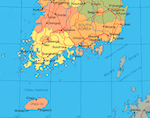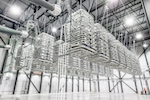A new cable link and two new converter stations will increase power and grid stability on South Korea’s Jeju Island.
ABB Power Grid’s business has been awarded the contract to build two substations for Korea Electric Power Corporation (Kepco), the country’s largest electric utility. One station, AC/DC, will be on the mainland at Wando, the other DC/AC for the local dsitributon system, will be built on Jeju Island, to the south of the peninsula. An undersea cable rated at 200 MW will transfer HVDC power to the island. The contract for construction of the cable link has not yet been awarded.
The substations will operate using voltage source conversion (VSC) technology, which ABB says will enable Kepco to operate the island’s existing interconnections more efficiently by providing additional stability and by minimising the risk of power outages.
Korea’s commitment
At the 2016 Paris Agreement on climate change, South Korea committed to reduce carbon dioxide emissions by 37 % by 2030 with Jeju Island leading the way. Jeju is one of the country’s nine provinces and its largest island. It receives most of its power from the mainland through two existing HVDC links (see panel).
“ABB is committed to supporting South Korea’s 2030 goal to a significant reduction of its carbon dioxide emissions. Our partnership with Kepco is an important milestone toward achieving this ambition,” said Claudio Facchin, president of ABB’s Power Grids business. [These] HVDC links will enable a greener and stronger grid and benefit both the local population, as well as the millions of tourists, who visit Jeju Island every year,” he added.
The technology
ABB will use its VSC technology HVDC Light for the two converter stations. HVDC is said to be the most efficient, cost-effective and environmentally friendly way to transport large amounts of electricity over long distances, with electrical losses of around 1 %. Its design incorporates features that can help control grid fluctuations and provide fast power restoration in the event of an outage. The new link will be the island’s third HVDC interconnector to the mainland, following the the Haenam–Cheju link, a conventional HVDC arrangement with two high-voltage cables and a sea return completed in 1998, and the Jindo-Jeju link, commissioned in 2014. The resulting system is complex, involving connections direct to the mainalnd and via the island of Jindo.
The existing mainland link
The second HVDC link tothe island, with cable supplied by LS Cable, is a 105 km HVDC submarine cable connection between the island of Jindo, close to the Korean Peninsula, and Jeju (Figure 1). When constructed the system had a capacity of 400 MW and transmission voltage of ±250 kV and was put into service in 2014. It is one of two links to the island, after the Haenam–Cheju link completed in the late 1990s. Cheju is an older spelling of Jeju, the official change occurring in 2000.
The Jindo–Jeju HVDC system is owned and operated by Kepco. The scheme is bipolar using a metallic return with a total of four cables: three mass-impregnated HV cables and one XPLE MV cable. Two of the high-voltage cables are normally used as the high-voltage conductors for the two converter poles and the medium-voltage cable is normally used as the neutral return conductor, but the third high-voltage cable is capable of being connected in parallel with, or instead of, any of the other three cables, offering a large number of possible operating modes. The converter stations use line-commutated converters with a conventional arrangement of a single twelve pulse bridge per pole.

